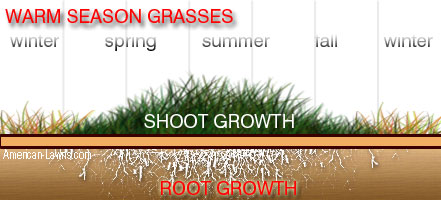When To Dethatch A Lawn. Best Time For Dethatching & Aeration
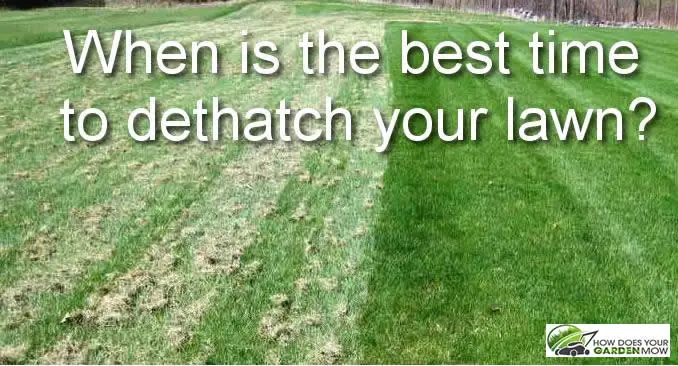
So the winter has passed and the sunny days have once again graced your garden. But there’s a problem, thatch build-up. It’s time to dig out the detacher.
Table of Contents
The best time to dethatch a lawn
When is the best time to dethatch a lawn?
The best time to dethatch a lawn depends on the season, where you live and the type of grass that is growing.
Typically the late spring and early fall are the best times to dethatch but a lot depends upon your grass type and the part of the country you live in.
For example, dethatching just after winter in northern states is a bad idea while it is perfectly fine to do this in more southern states where the climate is milder.
Additionally, warm season grass lawns should not be dethatched at the same time as cold season grass.
Let’s look into what that means and how you can use that information to determine the best time to detach your lawn.
First I will quickly cover the nature of thatch, and its detrimental effects on your lawn and garden, so that you better understand how to deal with it.
What thatch is & how it forms
Thatch is something that every garden and lawn has. It is perfectly natural and is, in fact, a healthy part of any lawn.
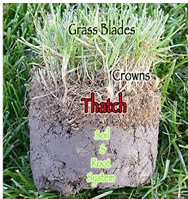 Thatch is made up of both living and dead bits of organic matter that consists of grass stems, twigs, leaves and old roots.
Thatch is made up of both living and dead bits of organic matter that consists of grass stems, twigs, leaves and old roots.
These organic elements intertwine and fuse together to form a layer of thatch just below the surface of the top soil.
Micro-organisms in the soil feed on this thatch and then pass back into the soil nutrients that help develop the roots of the grass in the lawn.
This cycle is very healthy for your lawn and keeps your lawn’s soil rich in nutrients.
However, thatch becomes problematic when it outgrows the ability of micro-organisms to break it down.
Simply put – thatch becomes a problem when it grows faster than it can be broken down. This is called thatch build-up.
Do not confuse the organic matter that leads to thatch build-up with grass clippings.
Grass clippings, especially from a mulching mower, that are left on the lawn will actually reduce the risk of thatch-build because as these clippings decompose they also help decompose the thatch.
The New York Times covered this very subject in great detail.
Why thatch is a problem
As I have already mentioned a healthy lawn has a certain amount of thatch.
You only have a lawn problem when the thatch layer gets so thick that water, oxygen and nutrients get blocked from getting to grass roots.
When the layer of thatch is more than ½” thick then you have thatch build-up and you need to dethatch.
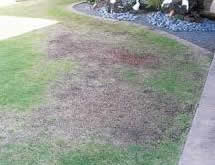 To determine how thick the thatch is in your lawn dig a small section up about 4″ deep and if there is a layer that exceeds ½ inch you need to dethatch.
To determine how thick the thatch is in your lawn dig a small section up about 4″ deep and if there is a layer that exceeds ½ inch you need to dethatch.
If you find the ground in your lawn is spongy to walk on then you have no need to perform the above check as you will definitely need to dethatch.
Common causes of excessive thatch
There is often more than one reason for thatch build-up in any given area.
Here are the main reasons thatch becomes problematic.
You may find that one or more of these reasons apply to your lawn.
Common reasons for thatch build-up:
- Not having dethatched for several years
- Not cutting the grass regularly
- Not raking leaves in the fall
- Cutting the grass too high
- Very heavy clay soil
- Over use of pesticides and fungicides which either kill or totally impede the growth of micro-organisms and earthworms in the soil
It is always a good idea to dethatch your lawn at least once per year just before you aerate it.
There are machines that can dethatch and aerate at the same time and these can be a big time-saver.
The best time to dethatch in your area
Dethatching can be tough on your lawn, so you really want to do it when the grass on your lawn will have the best chance to recover and grow healthy and vibrant grass blades.
For this reason you should not dethatch your lawn if the soil is very dry or very wet.
Under ideal conditions you should dethatch your lawn during growing season.
At this time it is under good growing conditions so the grass has the best chance of recovering. This is especially true if you plan to overseed after dethatching and aerating.
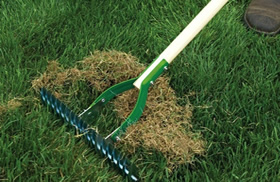 Generally, late spring and early fall are the best times for dethatching, but a lot depends upon your grass type and the part of the country you live in.
Generally, late spring and early fall are the best times for dethatching, but a lot depends upon your grass type and the part of the country you live in.
Power dethatchers seem to be the best option for people will large areas to clear or those who just don’t want to have to exert all that energy raking the lawn.
Manual scarifying rakes are still the most popular among residential users.
Dethatching just after winter in northern states is a bad idea while it is fine in the more southerly states.
Let’s take a look at why that is the case.
Northern States
In the colder states it is a almost an end-of-winter-ritual to start the dethatching process once the ice has melted.
Unfortunately, this is not a very good idea!
When ice melts it turns to water and that water lies on the lawn and soaks through into the turf.
Wet turf should not be dethatched or you run the risk of causing a lot of damage to your lawn.
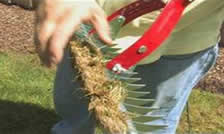 Also the act of walking around on very wet soil can compact it leading to the need for aeration.
Also the act of walking around on very wet soil can compact it leading to the need for aeration.
Therefore it is often best to wait until the early days of summer before dethatching in northerly states.
Southern States
Spring dethatching is usually fine in southern states as the ground will not be as wet.
If you wait until the summer the turf may be too dry to dethatch.
Really the key to dethatching is to ensure that the moisture in the ground is just right – neither too wet nor too dry.
The best time to dethatch depending on your grass type
Not only does your location effect what time of year is best to dethatch but the type of grass you have also effects it.
Cool season grass
As a general rule-of-thumb you should aim to dethatch lawns with cool season grass types in early spring or early fall.
The timing of this dethatching is very important.
In early spring you should dethatch only after the grass has started growing when the turf is moist but not overly wet. You should probably have already mowed it at least once.
If dethatching in the early fall then first allow the grass plenty of time to grow before the frost and cold weather arrives.
Here are some cool season grass types:
- Creeping bentgrass
- Fescue
- Kentucky bluegrass
- Rough bluegrass
- Ryegrass
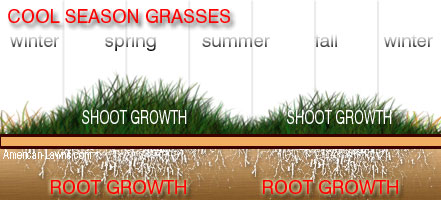 Warm season grass
Warm season grass
Lawns with warm season grasses, that been planted in regions that experience winter frost and snow, should be dethatched in the late spring or early summer.
Dethatching is best during those months because the ground has started to dry-out but still remains somewhat moist and malleable.
In warm regions of the country, such as Southern California and the Deep South, dethatch warm season grass in early spring, but be sure to wait until grass has started growing.
This means you should have already mowed at least once and possibly twice.
Here are some warm season grass types:
- Bermudagrass
- Bahia grass
- Buffalo grass
- Centipede grass
- St. Augustinegrass
- Zoysiagrass
How to dethatch without damaging your lawn
To dethatch your lawn you will need either a scarifier or a dethatcher. These come in hand tool form and in mechanical form.
The most common dethatchers are scarifying rakes which are very cheap are very effective.
The only down side to using a scarifying rake is the amount of manual labor involved.
Of course if you have the budget for it a dethatching machine is a great alternative.
An automated machine will speed up the entire process a lot and what’s more most of them are electric so they have a very low carbon footprint.
Don’t stop at dethatching – aeration is also key to a healthy lawn
If your lawn has a thatch-build-up problem then then odds are high that the lawn will also need to be aerated.
Even if you are unsure and it turns out that the lawn did not need aerated after all the act of aerating will cause it no harm (if it is done in under the right conditions).
There are multiple ways to aerate your lawn but when it comes to aerating and overseeding many people use aeration/seeder combo machines to make the job easier and faster.
Thanks for reading! I'm Michael — houseplant fanatic and your Pinterest plant guide.
Follow me on Pinterest for fresh updates 🌿

